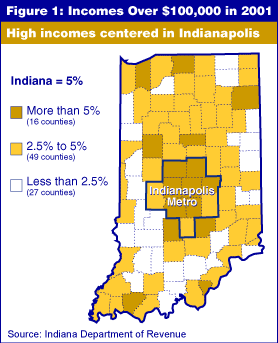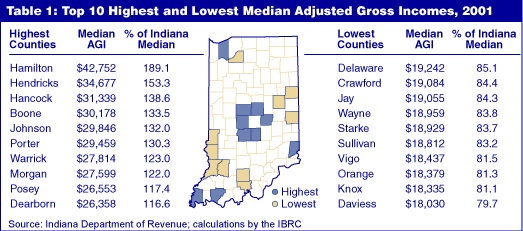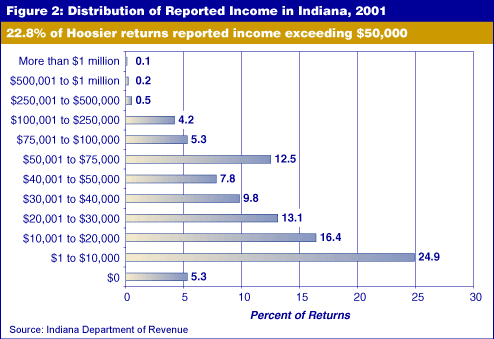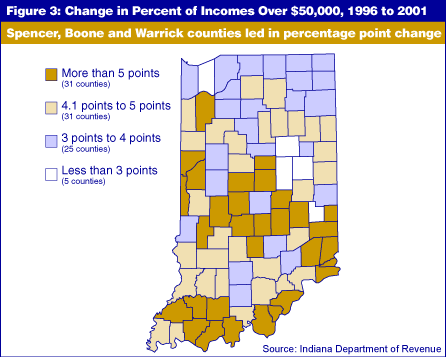Follow the Money: Indiana Income Tax Returns
Who wants to be a millionaire? More than 2,000 Indiana households could tell you what it’s like. Out of the 2.9 million individual income tax returns filed for 2001 with the Indiana Department of Revenue, 2,126 reported adjusted gross income (AGI) exceeding $1 million. Dropping the bar to a paltry half-million dollars raises the number of tax returns to 6,936.
Where are these well-heeled Hoosiers to be found? Not surprisingly, the largest number of million dollar returns (387) were filed from the state’s largest county, Marion. Other counties with more than 100 incomes over $1 million were Hamilton, Allen and St. Joseph. Lake County almost made the list with 98 millionaire returns.
Of course, one does not need to be a millionaire to have substantial buying power. Figure 1 compares Indiana counties on the percentage of tax returns reporting incomes over $100,000. Hamilton County led this list in 2001 (the most recent tax year for which data are available) by a wide margin at 18.6 percent of its returns, followed by Boone County at 12.3 percent. Altogether, 16 counties exceeded the state average of 5 percent of returns with incomes over $100,000. Of these, seven are in the Indianapolis metro area.

At the lower end of the income distribution, in 10 counties the median adjusted gross income calculated from tax returns was no more than about 85 percent of the Indiana median, which was $22,614. (Note: This figure is not the same as the median household income reported by the Census Bureau; this figure represents the adjusted gross income that is higher than half of the incomes reported on individual income tax returns.) These counties are shown in Table 1, along with the 10 counties with the highest median adjusted gross incomes.

As shown in Figure 2, more than 30 percent of all Indiana returns reported income of $10,000 or less, while 22.8 percent reported income exceeding $50,000 in 2001.

The distribution of incomes is generally rather stable over time, with a slight upward shift reflecting the gradual increase in average earnings (income figures reported here are not adjusted for inflation). Comparing Indiana individual income tax returns for 2001 with those filed for 1996 reveals a drop of 3.1 percentage points in the proportion of returns with incomes in the $1 to $10,000 range and a corresponding drop of 1.9 points in the $10,001 to $20,000 range. Over the same five-year period, the percentage of Indiana returns reporting incomes over $50,000 increased by 4.3 points, and the percentage of incomes over $75,000 increased by 3 points.
Figure 3 compares counties in terms of the five-year change in the percentage of incomes over $50,000. Spencer, Boone and Warrick counties enjoyed a change in incomes over $50,000 exceeding 7 percentage points, while counties with increases less than 3 percentage points in the above-$50,000 brackets were Delaware, Madison, Fayette, Porter and Grant.

Detailed data on incomes by county are available on STATS Indiana at www.stats.indiana.edu/taxes_topic_page.html.
Jerry Conover
Director, Indiana Business Research Center,
Kelley School of Business, Indiana University
